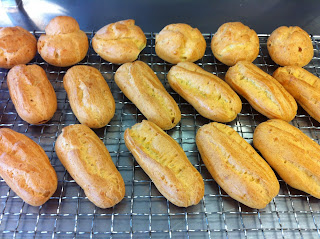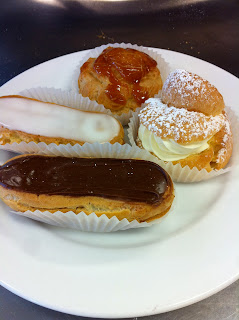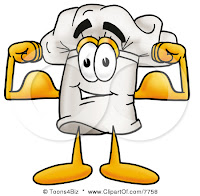Yes thats right readers we are now onto puff pastry. The mother and queen of all pastries.
There are a variety of different ways to make puff pastry. This lesson we did the French method and English method. No I am not picking sides of which one is the best at all. They were both just as difficult and just the same result. Our teacher likes the french version but alas, he is french. The French Method has 5 fold and the English has 6 folds. Confused?... read on dear reader :)
The recipe is very simple, it is the process that takes time and patience.
Puff Pastry:
500g bakers flour
10g salt
270g water + a couple drops of white vinegar
375g butter
This was my first time making puff pastry and let me tell you the folding and rolling and resting all got a little confusing for me and the more I tried to work it out the more I confused myself.
First you sift the flour and salt onto your clean bench and make a well in the centre. Add your water and vinegar mixture in the middle gradually working it into the flour to form a dough. Knead into a ball, cover in a wet cloth and refrigerate for about 20min. If you are doing the french method, at this point you would cut a cross in the top of your dough. If you are doing the english version you would form it into a rough rectangle/ball shape.
While your dough is resting in the fridge, beat your butter so it is a similar consistency to your dough, not too soft and not too hard. Your want to be able to roll out the butter in the pastry evenly with the pastry not have huge hard chunks of butter ripping your dough.
For the French Method; roll your dough out into a cross shape (sorry no photos... would have been so much easier to show you with photos) using the cuts your made on top and place the butter in the centre. Fold the edges in, overlapping them and making sure not butter is visible and roll out into a long rectangle. Fold (1st fold) evenly into three like you are folding a letter and turn 90 degrees around so the open ends are now the top and bottom. Roll out to a long rectangle and then fold (2nd fold) evenly into 3 again. Allow to rest for 20min in fridge.
For the English Method; Roll out rough rectangle to make it a little longer then roll out your butter into a rectangle a little smaller. Place butter on dough and fold in the sides. Roll out into a longer rectangle then fold into 3 (1st fold) like folding a letter, turn 90 degrees so open ends are at the top and bottom and roll out to a long rectangle, fold (2nd fold) in three again. Allow to rest in fridge for 20min.
French method & English method: Let your dough sit on the bench for a couple of min to take the chill of but not let warm up. Have the open ends facing the top and bottom and roll into a long rectangle like before and fold (3rd fold) in three. Repeat the rolling and folding (4th fold) once more making sure every time you roll you turn the dough so the open ends are always at the top and bottom. Allow to rest in fridge for 20min.
French: Roll out into a long rectangle for the last time and complete the final fold (5th fold). You can now roll out the pastry to your required thickness. We rolled it out into a large square 3mm thick.
English: Roll out into a long rectangle, fold into three (5th fold), turn 90 degrees. Roll and fold (6th fold) for the last time. Allow to rest for 20min. After the resting time you can roll out your pastry. We rolled it into a large square 3mm thick.
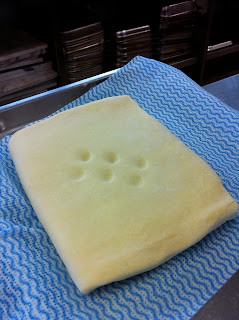 |
| English Puff with the marks for 6 fold completed. |
Making the palmiers and Victorias:
 |
| Cutting the Victorias |
 |
| Folding the victorias |
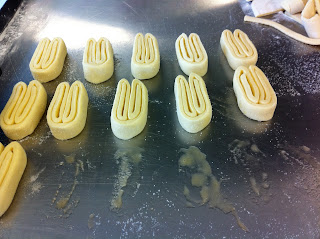 |
| Palmiers ready for the baking tray |
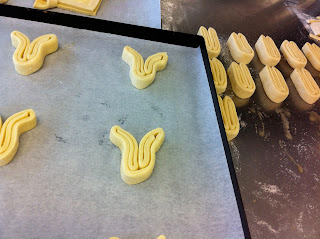 |
| Putting the bunny ears on the Palmiers. |
 |
| Palmiers baking |
 |
| Victorias baking with creme patissier and tinned apricots in them. |
 |
| Victorias straight from the oven. |
 |
| Palmiers straight from the oven. |
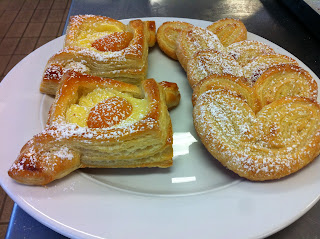 |
| The final products. |
Thanks for reading! keep watching for more delicious pastries :)

